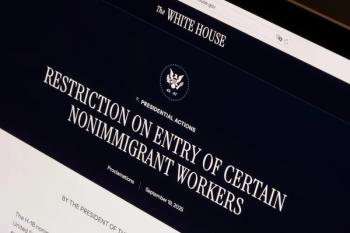
- Medical Economics September 2020
- Volume 97
- Issue 13
How the COVID-19 crisis is exacerbating physician burnout
Eventually, COVID-19 will be brought under control, but burnout will remain. Physicians will face the aftermath of a pandemic along with obtuse electronic health records, too much administrative work and too much third-party interference.
Early on in the COVID-19 pandemic, Gabe Charbonneau, M.D., a family doctor in Stevensville, Montana, completed a shift at an urgent care facility that was serving as the local COVID-19 clinic. “I saw one patient that day who had enough symptoms for me to think that they potentially could have COVID,” Charbonneau says. “I remember driving home and thinking about how I was going to make sure I didn’t bring this home to my family or community. That’s a scary thought — that there’s this potentially lethal infection that we really don’t know that much about spreading around.”
Still, Charbonneau feels fortunate. Montana has a relatively low infection rate, and his urgent care shift was a one-time volunteer event. But the pandemic has created a host of other issues for him and other physicians across the country. Doctors in hot spots saw massive increases in COVID-19-related cases, whereas those outside hot spots saw patient visits dry up. Layoffs and furloughs became common in health care, and telehealth had to be learned practically overnight to keep revenue coming in.
“Because it was such a financial hit, there was a lot of pressure for us to figure that out and start to actually get people back in the practice,” Charbonneau says. “There’s more work, and it’s really hard. And what about the stress from wondering if your patients are going to be safe when they come in or the safety of your staff, yourself or your family?”
Charbonneau, the founder of FightBurnout.org, has watched all these COVID-19-related issues pile on top of what physicians were already dealing with daily and knows it’s made burnout worse. “There are definitely days where it’s completely overwhelming to me and our staff,” he says.
And he knows that, unfortunately, he’s not alone.
How COVID-19 made a bad problem worse
In the Medical Economics® 2020 Physician Burnout Survey, 65% of physicians indicated that the COVID-19 pandemic has increased their feelings of burnout.
A big contributing factor to burnout in any profession is a lost sense of autonomy, and 32% of the doctors surveyed indicated that COVID-19 had contributed to a general feeling of helplessness. Physicians were already dealing with insurance companies about courses of treatment for patients prior to COVID-19, as well as being pressured to see more patients either by administrators or just to keep their practice open. The pandemic has added another layer.
“Many doctors had to sign a contract that said they could be deployed anywhere, sort of like they were in the army,” Charbonneau says. Doctors from many specialties in hot spots suddenly found themselves reassigned to the emergency department, treating patients with conditions they hadn’t seen since medical school. “You don’t really have a choice other than to not have a job, and that’s a big hit to your autonomy,” Charbonneau adds.
“Before COVID, we had physicians working long hours, not being in control, being told what to do, being devalued, being demeaned,” says Lynette Charity, M.D., a retired anesthesiologist and a physician advocate who speaks nationwide about the issue. “They don’t like their job, but they feel now they can’t leave, because they have to be there to take care of all these COVID cases. So in addition to what we were seeing with burnout before because of bureaucratic tasks, bad EHRs, no scribes and all the things that were going on, now we have the secondary situation of being on the front lines and seeing more death and destruction while being put in harm’s way.”
Shortages of personal protective equipment hit many health systems (29.9% of those surveyed indicated this was a problem), leaving doctors feeling dangerously exposed but fearful of speaking up. “If they speak out, they felt like they would be fired,” Charity says. “They feel like they have to work to take care of their families, but in the back of their mind, they are wondering if they’ll ever make it home to see them.”
For independent physicians, burnout was exacerbated by financial strain. According to the Medical Group Management Association (MGMA), 90% of medical groups have not been seeing patients who have COVID-19, and for them, patient volume dropped between 75% and 90% when the pandemic first hit the U.S.
“On top of the traditional causes of burnout, we added one massive and overarching one, which is ‘Can I stay in business?’” says Andy Swanson, M.P.A., CMPE, vice president of industry insights for MGMA. Physicians had to worry about job security for themselves and their staff, which isn’t something most have had to deal with.
In the Medical Economics® survey, just over half (50.4%) of respondents indicated that financial strain brought on by the pandemic contributed to their burnout. “Then there’s obviously the health and safety issue of workers, which adds this just enormous weight on people’s shoulders,” Swanson says; in the Medical Economics® survey, 46.9% of physicians indicated that this concern was a problem.
What needs to change
Eventually, COVID-19 will be brought under control, but burnout will remain. Physicians will face the aftermath of a pandemic along with obtuse electronic health records, too much administrative work and too much third-party interference. According to Charbonneau, burnout needs to be measured so progress can be tracked. “I don’t think we’ve been very good at quantifying burnout,” he says. “I really would like to see that kind of data where every three months, we’re checking a burnout inventory so we could directly see how things have changed.”
Categories such as workload and documentation burden could be measured along with a physician’s general feelings regarding work, he says. “To have a positive effect on burnout, we need to not look at the individual but look at the workplace and the factors in the workplace that are driving burnout,” Charbonneau says. “My concern is that there’s lots of talk about burnout but very little accountability. Unless there is sort of a financial impact that is directly connected to the bottom line, I don’t imagine it will change.”
A new system is needed that focuses on time with the patient, not on volume. “We say we value time with a patient, but what really drives the machine is RVUs (relative value units),” Charbonneau says. “The way to get more RVUs is either do more care or do more procedures.” That contributes to more burnout, he adds.
But with a pandemic sweeping across the country, is now the right time? “I can’t come up with a really good reason why you have to wait,” says Charbonneau, noting that the physician suicide rate is higher than that of the general population and that the hazards and workload of COVID-19 have many doctors looking for different careers. “I think saying we have to wait until the pandemic is over to solve it is probably going to be too late.”
How to cope
Although an individual physician may feel hopeless to change the health care system, their employer or their situation, there are strategies to recognize signs of trouble and take action.
First, a physician shouldn’t assume that he or she is the only one who is feeling burned out, says Bob Piccinini, D.O., a practicing psychiatrist in Sterling Heights, Michigan. “What we usually see when physicians are burned out is they look around and say, ‘Yeah, but everybody else is doing the same thing as I am and working long hours, and it doesn’t seem to affect them,’” he says. Others may be just as burned out but not saying anything because they, too, think they are alone in their feelings, Piccinini says.
Performance might also be affected, according to Piccinini: “Burnout often causes people to have poor decision-making capacity, make more mistakes in treatment and practice poor self-care.”
Common burnout signs include exhaustion, a reduced sense of accomplishment, a feeling of dread, increased irritability, inability to sleep, or using drugs or alcohol to cope, he says. Another sign: yelling at colleagues or overreacting when something doesn’t go right. “A lot of times in medicine, as much as we want to address our concerns about a colleague, we just don’t,” Piccinini says. “We give them a wider berth and just let them act out.”
Piccinini suggests taking a self-inventory to start the day. “What are my fears today?” he says. “Just identifying the emotion can help reduce anxiety.” Physicians dealing with a heavy COVID-19-related workload should try to pause for a short time between cases. “When the cases become blurred, they seem insurmountable. Try to deal with one thing at a time rather than everything at once,” he says.
Taking the time to check in on each other is the best thing physicians can do, Piccinini says. An informal “How are you doing?” after a critical incident can spark a conversation that helps alleviate emotions that would otherwise be internalized and fuel burnout. “Physicians often suffer in silence,” he says. “We got away from showing that we are human. Talking about burnout can be a great way of helping deal with it.”
Swanson advises that employed physicians focus on solutions when talking to administrators about the issues they are facing. “It’s rare in the workplace that anybody wants to sit with the curmudgeon or complainer and just listen to a gripe session for a half hour,” he says. “But people do empathize with hearing and listening to what some of the current issues and causes of burnout are, and are especially wanting to partner when that conversation turns quickly to what could be done to make it better.”
For a practice with a dearth of patients, physicians can use the extra time to invest in training that can alleviate burnout in the long term, when appointments return to a more normal level, Swanson says. If the EHR is a major point of frustration, find training sessions that can aid mastery of features, shortcuts and capabilities. “A doctor needs to make sure that this tool, as clunky as it may be for them, is as efficient as possible,” he says. “If someone can teach you one or two shortcuts or quick tricks, that can help ease the burden a little bit and put the physician more in control of how they use the tool.”
Outside of work, it’s important to find a focus other than medicine, whether it’s a project around the house or pursuing a hobby. “Even as terrifying as the world is right now, there is still a lot of beauty and things to be appreciative of, and once you start to condition yourself to that, it can go a long way toward maintaining your health,” Piccinini says.
Articles in this issue
almost 5 years ago
2020 Burnout Survey Results: Physicians facing unprecedented crisisabout 5 years ago
Mental health help is available for physiciansabout 5 years ago
2020 Coding Guide: Get Paid What You're Owedabout 5 years ago
What COVID-19 reveals about physician moral injuryabout 5 years ago
Nine tips for collecting patient balancesabout 5 years ago
Address social determinants improve patient outcomesabout 5 years ago
Social determinants: COVID-19 reveals societal gaps in careabout 5 years ago
Why my new practice is devoted to reversing chronic diseaseabout 5 years ago
Digitize admin tasks to reduce staff burdensabout 5 years ago
How practices can negotiate with a competing hospitalNewsletter
Stay informed and empowered with Medical Economics enewsletter, delivering expert insights, financial strategies, practice management tips and technology trends — tailored for today’s physicians.



















